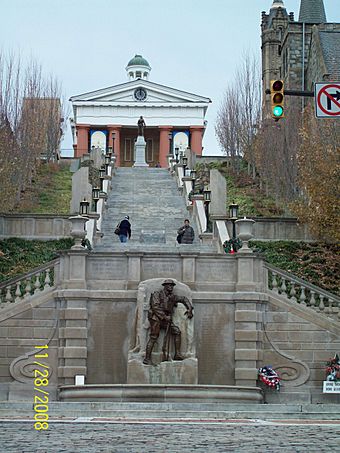Court House Hill–Downtown Historic District facts for kids
|
Court House Hill – Downtown
Historic District |
|

Monument Terrace, November 2008
|
|
| Location | Church, Clay, Court, Main Streets, roughly bounded by 5th through 13th Streets, Lynchburg, Virginia |
|---|---|
| Area | 7.5 acres (3.0 ha) |
| Built | 1815 |
| Architect | Chesterman, Aubrey |
| Architectural style | Federal, Late Victorian |
| NRHP reference No. | 01000853 (original) 02001361 (increase 1) 16000261 (increase 2) |
Quick facts for kids Significant dates |
|
| Added to NRHP | August 16, 2001 |
| Boundary increases | November 22, 2002 May 16, 2016 |
The Court House Hill–Downtown Historic District is a special area in Lynchburg, Virginia. It's like a time capsule showing how the city grew. This district sits on a hill overlooking the James River. It has many old buildings from the early 1800s to the mid-1900s. These buildings include churches, shops, homes, and government offices. They show off many different building styles from the past.
Contents
What is a Historic District?
A historic district is a special part of a city or town. It has many buildings that are important to history. These areas are protected to keep their unique look and feel. The Court House Hill–Downtown Historic District is one such place.
A Look at the Buildings
This district covers about 50 acres. It has many city blocks that are still much like they were long ago. You can find all sorts of buildings here. There are places of worship, businesses, homes, and government buildings.
Different Building Styles
The buildings in this district show many different styles. They were built over a long period, from the early 1800s to the mid-1900s. You can see styles like:
- Federal: An early American style, often simple and elegant.
- Greek Revival: Buildings that look like ancient Greek temples.
- Gothic Revival: Often seen in churches, with pointed arches and tall windows.
- Italianate: Inspired by Italian villas, with low roofs and tall, narrow windows.
- Queen Anne: Often colorful and decorative, with towers and wrap-around porches.
- Art Deco: A more modern style from the 1920s and 30s, with geometric shapes.
Why is it Special?
This district is so important that it was added to the National Register of Historic Places in 2001. This is a list of places in the United States that are worth saving. The district was made even bigger in 2002. This means more historic buildings were included in its protected area.
Famous Buildings in the District
Many buildings in this district are very special. Some are even listed on the National Register of Historic Places by themselves! Here are a few notable ones:
- Allied Arts Building
- Carter Glass House
- First Baptist Church
- Holy Cross Catholic Church
- Lynchburg Courthouse
- Lynchburg Furniture Company
- Monument Terrace
- St. Paul's Church
- John Marshall Warwick House
- Dicks-Elliott House
Gallery




